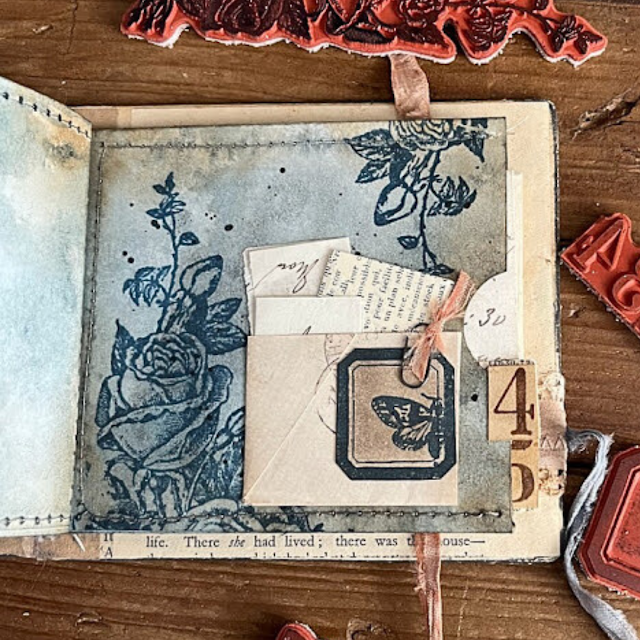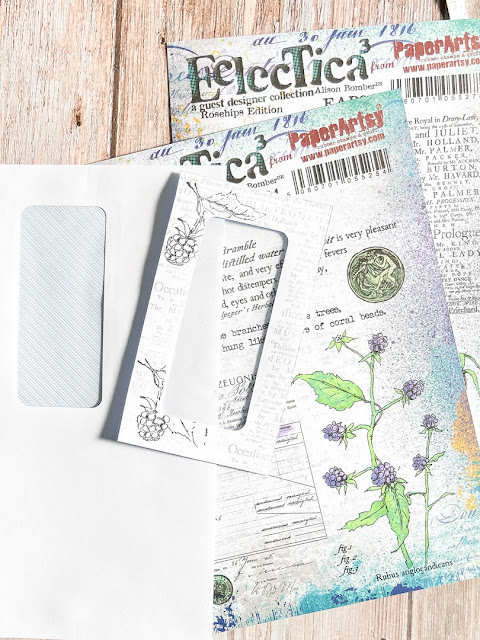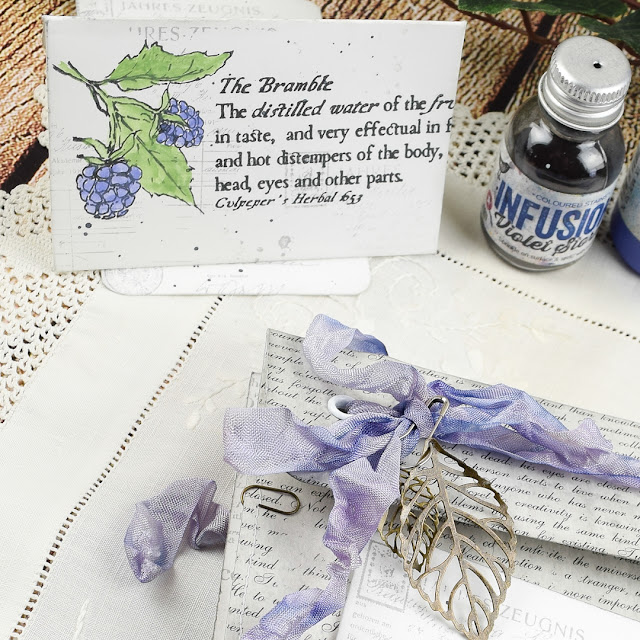
Hi everyone
It's Kaz Hall from The Maker's Table here with you today,
I've been really excited to share with you this vintage inspired project, that I have created for our current topic of 'Books & Journals' here on the PaperArtsy blog.
This topic had me thinking about how in this ever changing age of technology, books are still so important. There's something about starting a new chapter, turning a page, the enjoyment of finishing that last page and the excitement of starting the next book.
I love to collect old books, (I have quite a collection!) the typography, images and graphics, are often starting points of inspiration for me when creating.
For this project, I was keen to have lots of layers, along with hidden pockets, to stash away my ever growing collection of vintage ephemera.
So Grab yourself a cup of tea, this is quite a long blog post!
My book had a lovely embossed texture on the cover, which I really wanted to highlight in the background, so I decided to create paint layers using PaperArtsy Fresco Finish Chalk Acrylics to create a worn/distressed look. I will explain how I achieved this as you read on.
I loved the idea of blue and brown hues, so I decided on PaperArtsy 'In the Navy' Infusions for the main colour scheme, expecting this would continue throughout the whole project. Mattints come in the mix too, even though the colours I selected above are bright, you might be surprised how they end up!
As I mentioned previously, I selected this book. The cover is embossed, and I wanted to highlight that texture in the background.
I then set about dismantling the book by removing the insides with a craft knife, luckily it came out in one go!
As I only needed the patterned part of the book cover so I used a craft knife to remove the embossed title text from the top of the book along with the text from the bottom of the book. (Please be careful when using a craft knife!)
As the spine was still quite flimsy, so I set about reinforcing the spine, by adding a strip of cardboard, and added glued text pages to create the inside covers of the book.
Time to add some layers of PaperArtsy Fresco Finish Chalk Acrylics in sage and chalk; 3 - 4 thin coats and allowed it to dry.
This was followed by a thin layer of chocolate pudding and French Roast. Just before it dried, I wiped off that layer with a paper towel, which created a distressed look.
When the paint had dried, I took a piece of sandpaper and gently rubbed it over the dried paint. It revealed a lovely textured effect. (Don't worry if you rub to much off, you can add more layers of paint and repeat the process.)
I then took the Mattint (Squeezed) and using my finger I rubbed it over areas where I wanted the cover to look more defined, I added several layers.
To finish I added more of the PaperArtsy Fresco Finish Chalk Acrylic paint, this time in Hyde Park, I applied it to the edges and repeated sanding it back until I was happy with the results.
Next step was to think about the main focal point of the book. I started with Scrapcosy stamp set 04 (ESC04) and Versafine ink (Vintage sepia.) Here's an easy way to distress white card with infusions to make it appear more vintage and distressed.

- The image was stamped onto white card
- Clear embossing powder was sprinkled over the stamped image, and melted with a heat tool
- I sprinkled a tiny amount of 'In the Navy' Infusions onto my glass mat and generously spritzed water over to activate them
- The stamped image was pressed face down into the wet infusions, making sure the whole area was covered with them
When the card was dry, I masked off the image with a piece of card, diluted some chalk Fresco finish paint and added splashes of paint using a paintbrush to the edges of the infusions-distressed card.

I then repeated the steps above with the butterfly image from the same stamp set.
This time I used PaperArtsy Mattints to colour the image. The Mattints add a gentle pop of colour and allow you to build them up to the desired look. As they are totally transparent, the vintage blues of the infusions still allow an old, almost worn look.
I also added some Tim Holtz distress ink in Walnut stain to the edges.
Once it was coloured, I started to bring it all together by adding layers of text papers to the larger image. I stitched around the edges using my sewing machine and then attached the label and butterfly to complete the focal point.
I was really happy with how the infusions had coloured the card, it gave me the vintage look that I had wanted to achieve. I now wanted to continue this colour scheme to create page-pockets for inside the book.
For the next phase of this project, I needed to make pages for the revised 'book'. I decided a series of pockets work work well, so first I'm going to explain how to make these blue pockets as shown above. The same method of distressing the card with 'In The Navy' infusions was used, but first let me explain how the template was made.

- With a standard 4" x 6" (approx 15 x 10cm) greeting card. I measured my book to see what size the pockets needed to be, the pocket would measure 11cm.
- When cut to size I opened out the card and used a circle punch to punch half a circle.
- The 'score fold' is approx 1cm. This fold is is important as when the pockets are layered on top of each other and secured, this will allow the pockets to open when they have been filled with their contents.
- An example of a finished pocket, coloured, sewn and stamped
I decided to make 5 layers of 'pocket pages', so I repeated the process of colouring the pockets by using the Infusions, making sure to colour both external sides of the pocket. A small amount of glue was used along the inside fold of the pocket.
I used Stamp sets by Scrapcosy, ESC04 and ESC21. Ranger Distress Archival Ink (Faded Jeans) for the stamped images, and Ranger Distress Ink (Walnut Stain) around the edges.
I then layered up all the pockets on top of each other and used extra strong double sided tape to secured them together. I made a total of 5 pockets.
TIP: be mindful that the pockets will fill out when you have added things to them.
I then added all five pockets to the back cover of my book, again using extra strong double sided tape.
With the pockets now completed, now begins the final phase. It' time to decorate.
This is the really fun part; you can experiment with creative ways to make more hidden areas in your book. First I will share an easy, fun way to make your own envelopes.

To make an envelope, take a book page, or in my case I'm using an old letter.
- fold the paper in half and draw half a heart on to it. Cut it out
- you now have a heart shape; carefully fold in the curves of the heart
- turn the heart so the point of it it is at the top
- you can now see the envelope taking shape. Add a small amount of glue onto the folded flaps and fold into place
- completed envelope
Voila! All you now need to do is to fill your envelopes with whatever you want, a great hiding place for hidden messages.
There are so many different ways of creating pockets, sleeves, envelopes, folds... the fun part is experimenting with what works for you and your project. I often make a prototype of an idea, before committing to using an item that may not be easily replaced. I would encourage you to just have a play around, see what works for you.
Now you can see how all these elements come together. Remember we started with the cover of the book; the distressed panel, the infusions-coloured card, and the Mattint-coloured butterfly.
The view of the inside with the 5 pocket-pages stacked on the right. You can see I have decorated the inside left panel too. Ribbon softens and adds another interactive element. And the addition of the numbers shows there is lots more to discover within.
Scrapcosy's stamp set 21 (ESC21) is loaded with tags, labels and other useful elements, perfect for adding layers or interest to pages like these.
Here is the stack of pockets, the ribbon ...
Pocket 2 shows one of those Scrapcosy labels with some zig zag stitching ...
Pocket 3 ....
Pocket 4 ...
Pocket 5 ...
I really enjoyed creating this book, I love all the hidden areas that hide my vintage ephemera. I have really enjoyed using all the stamps, paints and Mattints to bring to life a new book from an old one.
Like most creatives, I am always open to learning new ideas, experimenting with techniques and finding my own way that works for me. I hope that by sharing some of my ideas from my book, it will inspire you to have a go at creating your own.
Thank you for sharing my love of all things vintage, enjoy your maker's journey!
Kaz
Facebook: The Maker's Table
Instagram: The Maker's Table
Blog: The Maker's Table
Website: The Maker's Table



































































.png)

